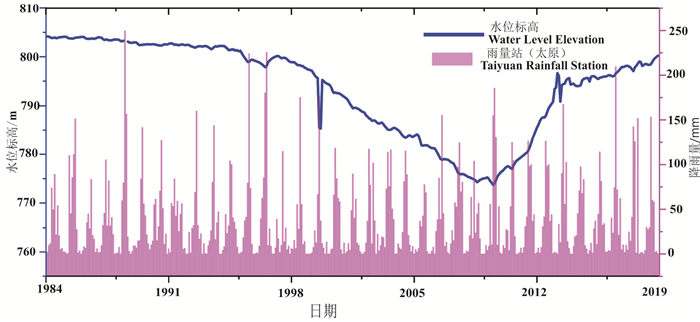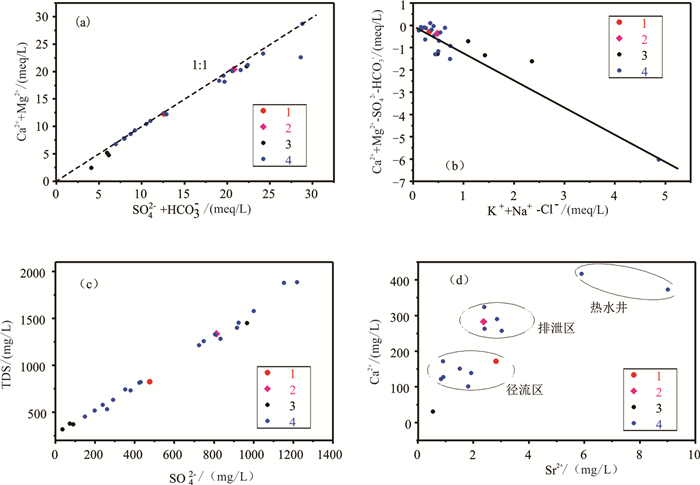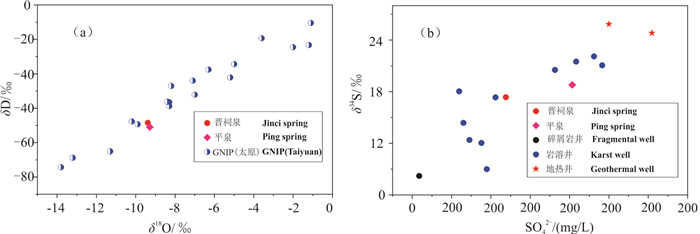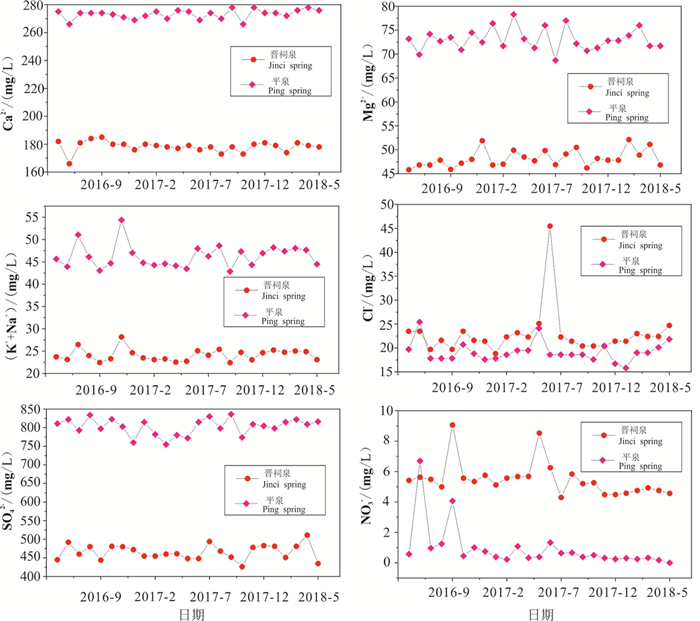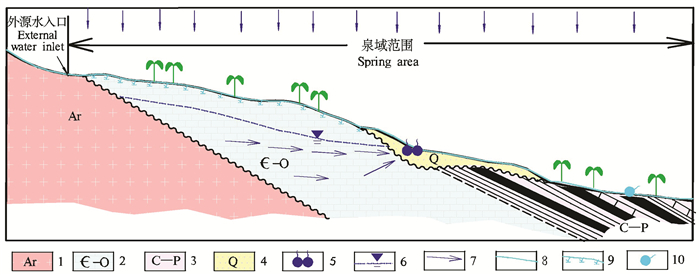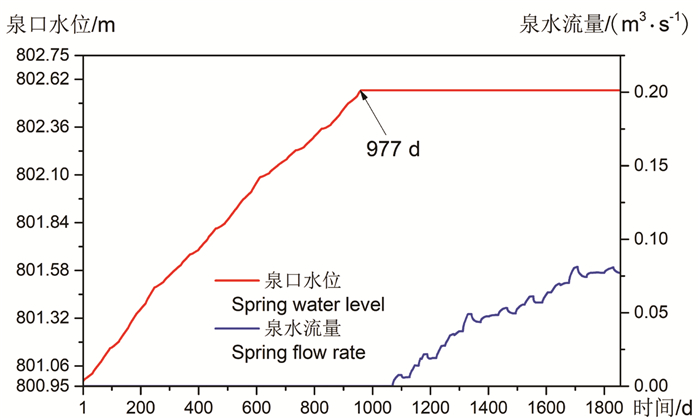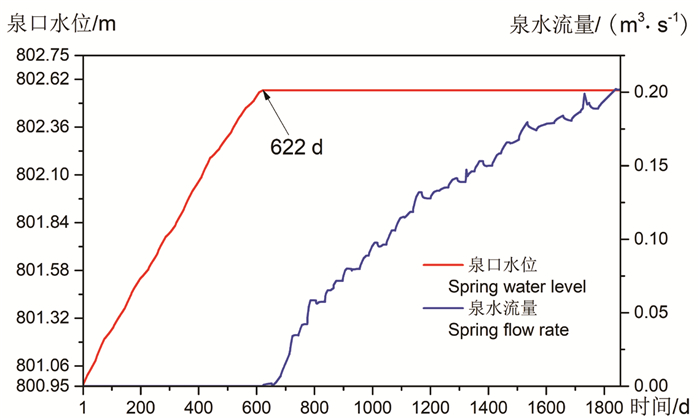Ecological restoration pattern and quantitative evaluation of recirculation measures for northern discontinuous karst spring: A case study of Jinci Spring in Taiyuan City, Shanxi Province
-
摘要:
岩溶大泉是中国北方岩溶地下水的主要天然排泄形式,它们集供水、旅游、生态等功能于一体,是重要的自然资源。自20世纪后期,受自然、特别是人类大规模开发、采煤等活动的影响,有近30%的岩溶大泉断流,其中不乏中外闻名的大泉。十七大以来,各地政府积极响应党中央国务院加强生态文明建设的号召,启动了一些重要断流岩溶大泉复流的生态修复工程。本文根据北方断流岩溶大泉的结构模式与成因,提出了包括利用上游水库蓄水、调节渗漏段河水流量、在河流渗漏段实施人工增补工程、在岩溶地下水强径流带和排泄区采取关井压采、封堵泉口下游自流井、对煤矿带压区进行监控、补给区分区植树造林措施的复流模式;以山西太原晋祠泉为实例,在对各项复流措施效果进行定量优化评价的基础上,得出抬高汾河二库水位至设计标高、关闭岩溶地下水强径流带内白家庄煤矿降压排水井、封堵处置泉口下游自流井是近期经济可行的有效措施的结论;最后利用建立的泉域地下水渗流数值模型,预测实施三项近期措施后,晋祠泉水可望在2年左右的时间实现复流,该结论以期为晋祠泉及北方岩溶区其他同类型岩溶泉水生态复流工作提供示范与参考。
Abstract:Karst spring is the main natural discharge form of karst groundwater in northern China and is an important natural resource with the functions of water supply,tourism and ecological environment. Nearly 30% of karst springs have been dried up,influenced by natural factors,coal mining,especially by human beings'large-scale development and utilization of karst groundwater since the last century. The dried-up springs also include some world-famous karst springs. Since the 17th National Congress of the Communist Party of China (CPC),local governments have actively responded to the call of the CPC Central Committee and the State Council to strengthen ecological civilization construction,and hence ecological restoration projects have been initiated for the reflow of some important karst springs. Based on the structural mode and genesis of the karst springs in northern China,this paper proposes the spring reflow pattern,which includes the following measures:regulating the water flow of the leakage section by using the water storage of the upstream reservoir,implementing artificial supplementary projects in the seepage section of the river,closing the wells in karst groundwater strong runoff zones and drainage areas,blocking artesian wells downstream of the spring water outlet,monitoring drainage in coal mines under pressure,and conducting afforestation measures in recharge zones. Taking Jinci spring in Taiyuan of Shanxi Province as an example and based on the quantitative optimization evaluation of the effects of these reflow measures,it is concluded that raising the storage level of the Fenhe Second Reservoir to the design elevation,closing the drainage well of Baijiazhuang coal mine in the strong runoff zone of karst groundwater to reduce water pressure,and plugging and disposing of artesian well downstream of spring outlet seem to be economically feasible and effective measures in the near future. Finally,by using the numerical model of spring groundwater,it is predicted that,after the implementation of these measures,Jinci spring water is expected to reflow in about two years. The results can provide demonstration and reference for other karst springs of the same type in northern China.
-
1. 引言
地下水中的化学成分可以示踪地下水的循环途径, 反映地下水流系统的特征;而地下水水化学类型是地下水化学成分的集中反映,也是地下水水文地球化学特征研究的重要内容之一(袁道先,1990;沈照理和王焰新,2002;王焰新等,2005)。水文地球化学结合同位素示踪的方法可更深入研究区域地下水的循环特征和水动力场特征(刘文波等,2010;李向全等,2011;郭晓东等,2014;袁建飞等,2016;孙厚云等,2018)。晋祠泉出露于太原西山悬瓮山下,由难老泉、圣母泉、善利泉组成,1954—1958年实测泉水平均流量为l.94 m3/s。与晋祠泉同处太原西山山前断裂带的平泉,1978年建立了特大型岩溶水自流井水源地,自流量最大达到1.56 m3/s。由于这些自流井的开采,使晋祠泉的流量急剧下降,1994年4月30日断流。为建设美丽山西,省政府将规划实施晋祠泉复流工程。因此研究晋祠泉的补给来源、晋祠—平泉水力联系成为一项重要课题。
2. 研究区概况
山西太原晋祠泉域位于太原盆地的北部,泉域面积2713 km2(梁永平等, 2019)。其碳酸盐岩含水层为下古生界寒武系和奥陶系,连续沉积厚度超过900 m。晋祠岩溶地下水主要接受西山碳酸盐岩裸露区及覆盖区的降水人渗补给、汾河及支流在碳酸盐岩段的渗漏补给(后期又加入水库渗漏补给)。晋祠泉域岩溶地下水排泄方式主要包括:晋祠泉、平泉、通过西山边山断裂带向盆地内松散层的潜流排泄以及人工开采井。晋祠泉位于北北东向晋祠断裂之南端,位于岩溶发育的排泄区,为西山岩溶地下水的天然集中排泄点,断裂西侧出露有奥陶系峰峰组石灰岩,断裂东侧为第四系松散层,岩溶地下水向东遇第四系松散层的阻挡而沿断裂上升溢出地表形成泉水(图 1)。晋祠泉群泉总流量在20世纪50年代平均为1.95 m3 /s,60年代为1.61 m3 /s,70年代为1.21 m3 /s,80年代为0.52m3/s(晋华等, 2005)。1960年以前基本上为天然动态。平泉则位于交城至清徐的北东东向断裂带之北端,晋祠泉的下游,是西山岩溶地下水的人工排泄点之一,泉水出露高程为784.31~86.87 m。2011年8月,清徐县平泉村“不老泉”和沙河底“水巷”两处泉水呈现复流迹象。2016—2018实测群泉总流量分别为0.067 m3/s、0.084 m3/s、0.114 m3/s。
3. 研究技术与方法
通过开展野外地质、水文地质补充调查,查明晋祠、平泉水文地质条件。于2016年5月在晋祠泉域边山断裂带取样24组。其中简分析9组,全分析15组(表 1)。2016年5月—2018年5月布置水质长观点两处,分别为晋祠泉口岩溶井、平泉村不老池泉水。pH、温度、电导率等指标直接通过WTW多功能水质监测仪现场测试获得;Ca、HCO3离子由德国默克测试盒现场滴定。化学分析在中国地质科学院岩溶地质研究所国土资源部重点实验室完成。2H/18O同位素(中国地质科学院岩溶地质研究所国土资源部重点实验室)测定精度分别为±2.0‰和±0.1‰;δ34S值在中国地质调查局武汉地质调查中心实验室完成测试,δ34S值采用IsoPrime质谱仪进行测定,δ34S值采用CDT(Canyon Diablo Meteorite)标准,测试精度优于±0.1‰。所有水样阴阳离子平衡相对误差小于5%,利用水化学模拟软件Phreeqc计算矿物饱和指数;利用Origin软件绘制离子比例系数图、同位素分析。
表 1 取样点基本信息Table 1. The information of sampling point
4. 晋祠—平泉水力联系分析
4.1 水位动态特征
地下水位动态变化,是反映含水层中地下水资源量变化的一个指征,地下水位的上升或下降,直接反映了地下水补给与消耗量的变化(陶虹等, 2013)。根据地下水水位动态监测资料分析,在1980年前,地下水水位的变化随降水量的大小而变化,呈稳定状态(图 2);1980—1992年,晋祠泉地下水水位的变化呈稳定下降趋势,主要原因是有太原化学工业公司、开化沟、淸徐县平泉村和梁泉村等水源地大量开采岩溶地下水,导致地下水水位下降;1993—2005年,整个泉域地下水水位急剧下降,主要原因是岩溶水开采量急剧加大和降水量减少(图 3);2005—2012年,泉域地下水水位呈上升趋势,主要原因是万家寨引黄工程,“关井压采”,部分工矿企业置换利用黄河水,中小煤矿整治与关停,汾河实施清水复流工程(二库修建),使泉域内岩溶地下水水位有明显回升(图 2)。
![]() 图 3 晋祠泉流量与岩溶水开采量变化趋势对比曲线(a)及晋祠泉—平泉流量关系线(b),资料来源山西省第一水文地质工程地质队;1—晋祠泉流量;2—晋祠泉域岩溶地下水开采量;3—平泉流量Figure 3. Comparison curve of Jinci spring discharge and karst water exploitation(a) and the discharge relation between Jinci spring versus Pingquan spring(b)1-Jinci spring flow; 2-Karst groundwater exploitation in Jinci spring area; 3- Pingquan spring flow
图 3 晋祠泉流量与岩溶水开采量变化趋势对比曲线(a)及晋祠泉—平泉流量关系线(b),资料来源山西省第一水文地质工程地质队;1—晋祠泉流量;2—晋祠泉域岩溶地下水开采量;3—平泉流量Figure 3. Comparison curve of Jinci spring discharge and karst water exploitation(a) and the discharge relation between Jinci spring versus Pingquan spring(b)1-Jinci spring flow; 2-Karst groundwater exploitation in Jinci spring area; 3- Pingquan spring flow4.2 水化学特征
岩溶水化学成分受区域内的地质条件、水动力条件和人类工程活动等因素的控制,并能够较好的保存这种影响“信息”。因此,水文地质工作者经常利用水文地球化学方法研究复杂的岩溶水系统(Smykatz-Kloss et al., 1990; Fairchild et al., 2006; Musgrove et al., 2010; Rui Ma et al., 2011;唐春雷等,2019)。依据工作所取得岩溶地下水,碎屑岩井水样分析结果,得出岩溶水pH值6.92~7.86,均值为7.35。钙离子95.3~417.0 mg/L,均值为226.9 mg/ L。硫酸根离子149~1219 mg/L,均值为633 mg/L。碎屑岩井水30.5~73.1 mg/L,均值为60.0 mg/L。硫酸根离子35~90 mg/L,均值为66 mg/L。岩溶水(泉)总体特征表现为阳离子高钙镁、低钾钠,阴离子低氯,高硫酸根。按照舒卡列夫分类法,研究区碳酸盐岩含水岩组地下水主要类型是Ca-SO4型与Ca-SO4·HCO3型。其中Ca-SO4·HCO3型主要分布在西山断裂带北部。Ca-SO4型主要分布在西山断裂带南部。碎屑岩井地下水主要类型是Ca · NaHCO3型。晋祠泉、平泉同为Ca-SO4型(表 2)。
表 2 晋祠泉域岩溶地下水水化学类型Table 2. Karst groundwater hydrochemical type of Jinci spring catchment
研究区岩溶地下水化学组分主要受方解石(文石)、白云石和石膏等矿物影响。SO42-+ HCO3-与Ca2++Mg2+关系图(图 4a)显示,岩溶地下水样品呈直线分布并偏离至1:1线以下,表明少量有煤矿排水,地表水的混入岩溶地下水中。Na++K+-Cl与Ca2++ Mg2+ - SO42-- HCO3-关系图(图 4b)显示,径流区部分点位于阳离子交换线附近,说明地下水水化学形成除方解石(文石)、白云石和石膏的溶解,还有阳离子交换作用。
![]() 图 4 龙子祠岩溶地下水离子关系图a—(SO4+ HCO3)-(Ca2++Mg2+)图; b—(Na++K+-Cl-)-(Ca2++Mg2+-SO4-HCO3)图; c—SO42+ -TDS图; d—Sr2+ -Ca2+图; 1—晋祠泉;2—平泉;3—碎屑岩井;4—岩溶井Figure 4. Ion relation diagrams of karst groundwater in Longzicia-(SO4+ HCO3)versus(Ca2++Mg2+); b-(Na++K+-Cl-)versus(Ca2++Mg2+-SO4-HCO3); c-SO42+ versus TDS; (d-Sr2+ versus Ca2+; 1-Jinci spring; 2-Pingquan spring; 3-Clastic rock well; 4-Karst well
图 4 龙子祠岩溶地下水离子关系图a—(SO4+ HCO3)-(Ca2++Mg2+)图; b—(Na++K+-Cl-)-(Ca2++Mg2+-SO4-HCO3)图; c—SO42+ -TDS图; d—Sr2+ -Ca2+图; 1—晋祠泉;2—平泉;3—碎屑岩井;4—岩溶井Figure 4. Ion relation diagrams of karst groundwater in Longzicia-(SO4+ HCO3)versus(Ca2++Mg2+); b-(Na++K+-Cl-)versus(Ca2++Mg2+-SO4-HCO3); c-SO42+ versus TDS; (d-Sr2+ versus Ca2+; 1-Jinci spring; 2-Pingquan spring; 3-Clastic rock well; 4-Karst well在TDS是反映水质的综合指标。研究区TDS与硫酸根含量存在着极高的线性相关(图 4c)。区域岩溶地下水中SO42-主要来源有奥陶系碳酸盐岩含水层石膏溶解,煤矿酸性水和大气降水中的硫酸根(张海潇等, 2019)。说明含水层石膏溶解,煤矿酸性水补给,大气降水中的硫酸根是影响TDS的主要因素之一。
岩溶水循环过程中,Sr2+浓度随着径流途径和水岩交互作用的时间而增加,相比之下Ca2+浓度却受制于溶解平衡,因此,不同来源的水的Sr2+/Ca2+值不同,径流途径和水岩交互作用的时间越长,其值越大,反之越小(Keul et al., 2017; Yokota et al., 2018; Pracný et al., 2019)。如图 4(d)所示岩溶水径流区(晋祠泉J17,J24,J13,J19,J18,J21,J20),排泄区(平泉,J04,J11,J10,J12,J01,J07),热水井(J16,J15) Sr2+浓度随着径流途径增加。热水井(J16,J15)Sr2+浓度最高,其原因是水岩交互作用的时间较长。
4.3 同位素环境特征
δ34S-SO42-被广泛用于追踪水中硫酸盐的来源氢(Temovski et al., 2018; Xiao et al., 2018; Zhou et al., 2018; Sim et al., 2019)。氢氧同位素是研究地下水起源与演化的理想示踪剂,可利用地下水中的稳定氢氧同位素识别研究区地下水补给来源(Schiavo et al., 2009; Capaccioni et al., 2011; Pasvanoğlu, 2013; Zhang and Li, 2019)。晋祠泉—平泉段岩溶地下水的δ18O变化在-9.7‰~-8.5‰,δD变化在-70.1‰~-63.9‰,平均值分别为-9.3‰和-68.4‰。,该段岩溶水样点均散落于太原站大气降水线右下方(图 5a),表明其主要补给来源为大气降雨。晋祠—平泉一带岩溶地下水氢氧同位素值较接近,说明这一带补给来源与补给途径相近。
地下水中硫酸盐主要有3种来源,即降水、蒸发岩溶解和硫化物或有机硫氧化。在水文地球化学研究中,常使用δ34S对水中硫酸盐的来源进行标定。大量研究表明,山西中奥陶统石膏的δ34S值为23.8‰ ~31.4‰,矿坑水中的δ34S值为- 13.6% ~ 7.98‰,新近系黄土中δ34S值为5.5‰~9.5‰,汾河及其支流与引黄水的中δ34S值7.9‰~10.66‰。从晋祠泉—平泉段岩溶水δ34S分布图(图 5b),可以看出,岩溶地下水的δ34S值总体较大,接近于石膏的δ34S值范围,说明岩溶地下水中的SO42-主要来源于石膏溶解。
4.4 晋祠—平泉水化学水质监测分析
为了分析晋祠—平泉水力联系的水化学证据,在晋祠难老泉、不老池开展了逐月水化学含量动态监测(Ca2+、Mg2+、K++Na+、Cl-、SO42-、NO3-)。2016年5月至2018年5月共50组水样,如图 6所示晋祠泉与平泉各个离子变化趋势基本一致。说明晋祠与平泉存在紧密的水力联系。平泉Ca2+、Mg2+、SO42-、K++Na+含量显著高于晋祠泉,而Cl-、NO3-含量则低于晋祠泉。
4.5 径流途径水化学演化
反向地球化学反应路径模拟是定量研究水文地球化学演化的重要手段。反应路径模拟的理论基础是沿地下水同一水流路径,终点的水化学成分和同位素的质量等于起点的水化学成分和同位素的质量加上两点间由于水岩作用(如沉淀、溶解、阳离子交换等)、蒸发作用和不同水流的混合作用引起的化学组分和同位素的转移量,通过质量平衡反应模型和同位素质量传输模型,可推测地下水从起点到终点间的水文地球化学反应路径(Plummer et al., 1990; Petalas and Lambrakis, 2006; Han et al., 2011; Cánovas et al., 2016)。
4.5.1 饱和指数与可能矿物相的确定
饱和指数能反映常见的含有碳酸盐类、硫酸盐类和硅酸盐类等矿物与地下水之间所处的溶解平衡状态,这是反向水文地球化学模拟计算的基础。利用Phreeqc计算各矿物饱和指数(表 3),由表 3可以看出:方解石、文石、白云石的饱和指数均大于0,说明它们在地下水中呈饱和状态,具有沉淀趋势;石膏、硬石膏和岩盐的饱和指数均小于0,说明它们在地下水中处于非饱和状态,具有继续溶解趋势。依据饱和指数分析结果,选择石膏、方解石、白云石、NaCl,作为水文地球化学模拟的“可能矿物相”。
表 3 岩溶地下水中矿物饱和指数Table 3. Mineral saturation index in karst groundwater
4.5.2 Phreeqc水化学模拟
应用Phreeqc软件确定了水中各种组分和矿物的饱和状态;通过物质平衡模型,来确定岩溶地下水系统径流路径上不同两点之间矿物沉淀或溶解的数量。晋祠—平泉径流路径发生的主要水岩作用为:石膏的溶解,方解石沉淀、岩盐稀释和二氧化碳气体溶解或逸出等。
5. 对晋祠泉复流的贡献
晋祠泉与平泉同属于一个晋祠泉岩溶地下水系统,都位于西山山前边山断裂带的排泄区。晋祠与平泉存在紧密的水力联系。说明晋祠泉与平泉存在一个比较强的导水通道。可以通过在晋祠泉下游导水通道上帷幕灌浆,提高晋祠泉水水位,使晋祠泉出流。此方案的优点:(1)晋祠泉水水质明显优于平泉。(2)降低下游带压煤矿开采突水的风险。(3)晋祠泉水出流以地表水渠形式管理调度,生态人文环境影响较小。
6. 结论
(1) 在1980年前,晋祠泉地下水水位的变化随降水量的大小而变化,呈稳定状态;1980—1992年,地下水水位的变化呈稳定下降趋势,主要原因是大量开采岩溶地下水;2005—2012年,地下水水位呈上升趋势,主要原因是万家寨引黄工程,关井压采,部分工矿企业置换,汾河实施清水复流工程(二库修建),使泉域内岩溶地下水水位有明显回升。
(2) 研究区碳酸盐岩含水岩组地下水主要类型是Ca-SO4型、Ca-SO4·HCO3型。Ca-SO4·HCO3型主要分布在西山断裂带北部。Ca-SO4型主要分布在西山断裂带南部。碎屑岩井地下水主要类型是Ca·Na-HCO3型。晋祠泉、平泉同为Ca-SO4型。
(3) 晋祠泉的δ18O和δD值分别为- 9.39‰,- 68.5‰。平泉的δ18O和δD值分别为- 9.29‰,-71.0‰。其点均散落于太原站大气降水线右下方,表明晋祠泉与平泉的主要补给来源为大气降雨,氢氧同位素值较接近,说明晋祠泉与平泉补给来源与补给途径相近。研究区岩溶地下水的δ34S值总体较大,接近于石膏的δ34S值范围,说明岩溶地下水中的SO42-主要来源于石膏溶解。
(4) 晋祠与平泉存在紧密的水力联系,晋祠泉与平泉存在一个比较强的导水通道。可以通过帷幕灌浆,提高晋祠泉水水位,使晋祠泉出流。
致谢: 论文编写中得到了山西水利厅梁文彪教授级高级工程师、骈元高级工程师的帮助和中国地质研究监测院李文鹏教授级高级工程师的指导,谨此表示衷心感谢! -
图 1 “单斜顺置型”泉域结构剖面图
1—岩溶水隔水底板;2—碳酸盐岩含水层;3—岩溶水煤系地层隔水顶板;4—松散层;5—岩溶泉水;6—岩溶地下水位;7—岩溶地下水流向;8—地表水;9—地表水渗漏段;10—碎屑岩裂隙泉水
Figure 1. Geological section of monoclinic concordant-type spring domain structure
1-Waterproof floor of karst groundwater; 2-Carbonate aquifer; 3-Waterproof roof of karst groundwater; 4-Unconsolidated formation; 5-Karst spring; 6-Contour of karst groundwater table; 7-Karst groundwater flow direction; 8-Surface water; 9-The location of surface water leakage; 10-Clastic rock spring
图 2 大型断流泉水生态修复工程部署示意图
1—岩溶水隔水底板;2—碳酸盐岩含水层;3—松散层含水层;4—岩溶水煤系地层隔水顶板;5—水库;6—岩溶水等水位线;7—河流;8—引水工程线路;9—河流渗漏段;10—煤矿;11—自流井;12—岩溶泉水与碎屑岩泉水;13—开采井;14—渗坑、渗渠等;15—水源地;16—复流工程措施编号
Figure 2. Schematic diagram showing the deployment of the ecological restoration project of large discontinuous spring
1-Karst water resisting floor; 2-Carbonate aquifer; 3-Unconsolidated rock aquifer; 4-Karst water resisting roof; 5-Reservoir; 6-Karst water level; 7-River; 8-Water diversion project route; 9-River leakage section; 10-Coal mine; 11- Artesian well; 12-Karst spring and clastic rock spring; 13- Well; 14-Seepage pit and channel; 15-Water source; 16-Serial number of measure of reflow engineering
图 3 晋祠泉水复流工程措施部署图
1—碳酸盐岩裸露区;2—碳酸盐岩覆盖区;3—碳酸盐岩埋藏区;4—非碳酸盐岩区;5—汾河水库;6—汾河二库;7—煤矿带压区;8—晋祠泉域边界;9—河流;10—引黄工程线路;11—复流工程措施编号;12—自流井;13—外源水入口;14—水源地;15—岩溶泉水及名称;16—植树造林水源涵养区;17—岩溶水开采井;18—岩溶水流动方向;19—煤矿
Figure 3. Schematic diagram showing the reflux project measures deployment of the Jinci Spring
1-Carbonate outcrop area; 2-Carbonate covered area; 3-Carbonate burial area; 4-Non-carbonate zone; 5-Fenhe Reservoir; 6-Fenhe Second Reservoir; 7-Coal mine pressure area; 8-Jinci Spring region boundaries; 9-River; 10-Yellow River Diversion Project line; 11-Serial number of measure of reflow engineering; 12-Artesian well; 13-External surface water inlet; 14-Water source; 15-Karst spring and its name; 16- Afforestation and water conservation area; 17-Karst groundwater well; 18-Karst groundwater flow direction; 19-Coal mine
表 1 晋祠泉口对主要补给方案的水位响应
Table 1 The groundwater level response of Jinci spring to the main supply scheme

表 2 不同岩性地区日蒸散量和月蒸散量
Table 2 Daily and monthly evapotranspiration in different lithology areas

-
Chai Junfang. 2011. Discussion on the development and protection of Huo Spring karst groundwater[J]. Shanxi Water Resources, 27(08):15-16(in Chinese).
Chen Junfeng, Li Xiubin. 2001. The impact of forest change on watershed hydrology-Discussing some controversies on forest hydrology[J]. Journal of Natural Resources 15(5):475-478 (in Chinese with English abstract).
Chen Xiaohui. 1989. The leakage of Yang Maowan reservoir and the re-flow of Long Yansi spring[J]. Hydrogeology and Engineering Geology, (1):48-52 (in Chinese).
Dang Yuejun. 2016. Analysis of Leakage in Gujiao Reach of Fenhe River in Jinci Spring Basin[J]. Journal of China Hydrology, 36(2):62-66 (in Chinese with English abstract).
Gao Bo. 2002. Causes of flow rate decrease of Guozhuang Spring and countermeasures[J]. Water Resources Protection, (1):64-65 (in Chinese). http://www.researchgate.net/publication/288231144_Causes_of_flow_rate_decrease_of_Guozhuang_Spring_and_countermeasures_J
Gao Yangyang, Zuo Qiting. 2009. Impact research of vegetation cover change on the total evapo-transpiration in a watershed[J]. Journal of Water Resources & Water Engineering, 20(2):26-31 (in Chinese with English abstract). http://en.cnki.com.cn/Article_en/CJFDTOTAL-XBSZ200902009.htm
Guo Fangfang, Liang Yongping, Wang Zhiheng, Shen Haoyong, Zhao Chunhong. 2018. Attribution of spring fields and calculation of seepage of the second reservoir of Fenhe River in Xishan mountain, Taiyuan, Shanxi Province[J]. Carsologica Sinica, 37(3):228-238 (in Chinese with English abstract).
Hu Ziying, Zhou Junju, Zhang Lili, Wei wei, Cao Jianjun. 2018.Climate dry-wet change and drought evolution characteristics of different dry-wet areas in northern China[J]. Acta Ecologica Sinica, 38(6):1908-1919 (in Chinese with English abstract).
Jian Yuxiang, Fan Yongping, Sun Rui, Wei Lufeng. 2018. Analysis of groundwater environmental impact and protection measures of Jinci spring water replenishment project[J]. Design of Water Resources & Hydroelectric Engineering, 35(4):20-22 (in Chinese).
Jin Xiaomei, Guo Renhong, Xia Wei. 2013. Variation of regional evapotranspiration of Qaidam Basin using MODIS data[J]. Hydrogeology & Engineering Geoloy, 40(6):8-12 (in Chinese with English abstract). http://en.cnki.com.cn/Article_en/CJFDTotal-SWDG201306004.htm
Li hui. 2011. Discussion on water resources management in taiyuan water-supply area of Shanxi Wangjiazhai Yellow River Diversion Project (YRDP)[J]. Sci-Tech Information Development &Economy, 21(16):166-169(in Chinese with English abstract). http://www.zhangqiaokeyan.com/academic-journal-cn_science-technology-information-development-economy_thesis/02012299336.html
Li Huiyun, Zhang Yongqiang, Wang Bende. 2012. Separating impacts of vegetation change and climate variability on streamflow using hydrological models together with vegetation data[J]. Scientia Sinica Technologica, 42(8):963-971 (in Chinese). doi: 10.1360/ze2012-42-8-963
Li Xilin, Wang Laigui, Han Liang. 2008. Study on of the mechanism water-rock interaction of mine water from abandoned mines during infiltration through coal rock[J]. Journal of Water Resources and Water Engineering, 19(5):11-14 (in Chinese with English abstract).
Li Yue, Liu Jiahong, Sang Xuefeng, Yuan Fei. 2013. Study on ecowater diversion quantity for clean water restoration of Fenhe River[J], Water Resources and Hydropower Engineering, 44(9):21-25(in Chinese with English abstract). http://en.cnki.com.cn/Article_en/CJFDTOTAL-SJWJ201309007.htm
Li Yushan. 2001. Effects of forest on water circle on the Loess Plateau[J]. Journal of Natural Resources, 16(5):420-426 (in Chinese with English abstract).
Liang Tengfei, Cheng Jianmei, Zhang Naiyan. 2020. Numerical study on surface water leakage replenishment of the Fenhe 2nd reservoir into the Jinci spring system[J]. Carsologica Sinica, 39 (2):147-153(in Chinese with English abstract).
Liang Yongping, Gao Hongbo, Zhang Jianghua, Huo Jianguang, Wang Taoliang. 2005. Preliminary quantitative analysis on the causes of discharge attenuation in Niangziguan spring[J]. Carsologica Sinica, (3):227-231(in Chinese with English abstract).
Liang Yongping, Gao Xubo, Zhao Chunhong. 2018. Review characterization, evolution, and environmental issues of karst water systems in Northern China[J]. Hydrogeology Journal, 26:1371-1385. doi: 10.1007/s10040-018-1792-4
Liang Yongping, Han Xingrui, Wang Weitai, Zhao Chunhong. 2013.Variations of karst water environmental problems in North China[J]. Carsologica Sinica, 32(1):34-42 (in Chinese with English abstract).
Liang Yongping, Shi Donghai, Li Chunji, Wang Weitai, Zhao Chunhong, Li Xiaofeng, Wei Yanhua, Xu Fengwei. 2011. Test and research on the relationship between runoff and leakage on a karst percolation zone[J]. Hydrogeology & Engineering Geology, 38(2):19-26 (in Chinese with English abstract).
Liang Yongping, Wang Weitai. 2010. The division and characteristics of karst water systems in Northern China[J]. Acta Geoscientica Sinica, 21(6):860-868 (in Chinese with English abstract).
Liang Yongping, Zhang Fawang, Shen Haoyong, Tang Chunlei, Zhao Chunhong, Wang Zhiheng, Hou Hongbin, Ren Jianhui, Guo Fangfang. 2019. Recognition of the critical hydrogeological condition of Jinci Spring and Lancun Spring[J]. Hydrogeology and Engineering Geology, 46(1):11-18 (in Chinese with English abstract). http://en.cnki.com.cn/Article_en/CJFDTotal-SWDG201901002.htm
Luan Qinghua, Li Wei, Liu Jiahong, Chu Junying. 2015. Ecological influence and value evaluation of Fenhe River water diversion in order to reflow[J]. Yellow River, 37(5):62-65(in Chinese with English abstract).
Ma Teng, Wang Yanxin, Hao Zhenchun. 2001. The cause analysis for the declining discharge of Shen Tou spring and the forecast of its evolution trend[J]. Carsologica Sinica, 20(4):261-267(in Chinese with English abstract).
Niu Lei, Chen Li, Jiang Shengguo, Jia Chao. 2014. Study on influence of coal mining on aquifer——A case study on diggings in Jiaozuo[J]. Groundwater, 36(1):45-47 (in Chinese with English abstract).
Shen Haoyong, Liang Yongping, Cheng Yanng. 2017. Study on the regionai evapotranspiration over different surface conditions of the Longzici spring drainag[J]. Carsologica Sinica, 36(2):234-241 (in Chinese with English abstract).
Wang Guoli, Liang Guohua, Nie Xiangtian. 2007. Research on groundwater management model and its application based on unit pulse saline intrusion response matrix[J]. Journal of Dalian University of Technology, 47(4):589-592(in Chinese with English abstract).
Wang Junping. 2015. Analysis and suggestion on flow attenuation of Chengtouhui Spring[J]. Soil and Water Conservation Science and Technology in Shanxi, (3):30-31.
Ye Haidong. 2006. Study on the Reasons of the Flow Reduction of the Longzici Karst water and protecting measures[J]. Sci-Tech Information Development & Economy, (15):148-149(in Chinese with English abstract).
Yuan Daoxian. 2010. The situation and tasks for northern karst research of our country[J]. Carsologica Sinica, 29(3):219-221 (in Chinese with English abstract).
Zhang Xingan. 2004. Study on the leakage of Taoqupo reservoir in Shaanxi Province[J]. Groundwater, 26(2):150-152 (in Chinese).
Zhao Weili. 2013. The relationship between Pingquan Spring and Jinci Spring and the possibility analysis on Jinci Spring's Reflow[J]. Shanxi Hydrotechnics, (4):83-89 (in Chinese).
Zhou Xiaofeng, Zhao Huixun, Sun Huizhen. 2001. Proper assessment for forest hydrology effect[J]. Journal of Natural Resources 16(5):420-426 (in Chinese with English abstract).
柴俊芳. 2011.霍泉岩溶地下水开发及保护对策探讨[J].山西水利, 27(08):15-16. 陈军锋, 李秀彬. 2001.森林植被变化对流域水文影响的争论[J].自然资源学报, 15(5):475-478. 陈晓晖. 1989.羊毛湾水库渗漏与龙岩寺泉水复现[J].水文地质工程地质, (1):48-52. 党跃军.2016.晋祠泉域汾河干流古交段河道渗漏分析研究[J].水文, 36(2):62-66. 高波. 2002.郭庄泉流量衰减原因分析及对策[J].水资源保护, (1):64-65. 郭芳芳, 梁永平, 王志恒, 申豪勇, 赵春红. 2018.山西太原西山汾河二库的泉域归属及其渗漏量计算[J].中国岩溶, 37(3):228-238. 高洋洋, 左其亭. 2009.植被覆盖变化对流域总蒸散发量的影响研究[J].水资源与水工程学报, 20(2):26-31. 胡子瑛, 周俊菊, 张利利, 魏伟, 曹建军. 2018.中国北方气候干湿变化及干旱演变特征[J].生态学报, 38(6):1908-1919. 菅宇翔, 范永平, 孙瑞, 魏路峰. 2018.晋祠泉补水工程的地下水环境影响及保护措施分析[J].水利水电工程设计, 35(4):20-22. 金晓媚, 郭任宏, 夏薇.2013.基于MODIS数据的柴达木盆地区域蒸散量的变化特征[J].水文地质工程地质, 40(6):8-12. http://d.wanfangdata.com.cn/Periodical/swdzgcdz201306002 李辉. 2011.试论万家寨引黄工程太原供水区水资源管理[J], 科技情报开发与经济, 21(16):166-169. 李慧赟, 张永强, 王本德. 2012.基于遥感叶面积指数的水文模型定量评价植被和气候变化对径流的影响[J].中国科学:技术科学, 42(8):963-971. http://www.wanfangdata.com.cn/details/detail.do?_type=perio&id=zgkx-ce201208014 李喜林, 王来贵, 韩亮. 2008.废弃煤矿矿井水在煤岩体入渗过程中的水岩作用机理研究[J].水资源与水工程学报, 19(5):11-14. http://d.wanfangdata.com.cn/Periodical/xbszyysgc200805003 李玉山. 2001.黄土高原森林植被对陆地水循环影响的研究[J].自然资源学报, 16(5):462-430. http://www.cqvip.com/Main/Detail.aspx?id=5472218 李悦, 刘家宏, 桑学峰, 袁飞. 2013.汾河清水复流生态水量研究[J].水利水电技术, 44(9):21-25. 梁腾飞, 成建梅, 张乃俨. 2020.基于数值模拟的汾河二库对晋祠泉岩溶水系统渗漏补给作用研究[J].中国岩溶, 39(2):147-153. 梁永平, 高洪波, 张江华, 霍建光, 王桃良. 2005.娘子关泉流量衰减原因的初步定量化分析[J].中国岩溶, (3):227-231. http://www.cnki.com.cn/Article/CJFDTotal-ZGYR200503010.htm 梁永平, 韩行瑞, 王维泰, 赵春红. 2013.中国北方岩溶水变化特征及其环境问题[J].中国岩溶, 32(1):34-42. 梁永平, 石东海, 李纯纪, 王维泰, 赵春红, 李晓峰, 魏燕花, 徐峰伟. 2011.岩溶渗漏河段来水量与渗漏量间关系测试研究[J].水文地质工程地质, 38(2):19-26. http://d.wanfangdata.com.cn/Periodical/swdzgcdz201102004 梁永平, 王维泰. 2010.中国北方岩溶水系统划分与系统特征[J].地球学报, 21(6):860-868. http://d.wanfangdata.com.cn/Periodical/dqxb201006010 梁永平, 张发旺, 申豪勇, 唐春雷, 赵春红, 王志恒, 侯宏冰, 任建会, 郭芳芳. 2019.山西太原晋祠-兰村泉水复流的岩溶水文地质条件新认识[J].水文地质工程地质, 46(1):11-18. http://www.cqvip.com/QK/90596X/20191/7001447104.html 栾清华, 李玮, 刘家宏, 褚俊英. 2015.汾河清水复流工程生态影响及价值评价[J], 人民黄河, 37(5):62-65. http://www.cqvip.com/QK/95810X/20155/664769929.html 马腾, 王焰新, 郝振纯.2001.神头泉流量衰减原因分析及趋势预测[J].中国岩溶, 20(4):261-267. http://www.cnki.com.cn/Article/CJFDTotal-ZGYR200104004.htm 牛磊, 陈立, 江胜国, 贾超. 2014.采煤对地下含水层的影响研究-以河南焦作矿区为例[J].地下水, 36(1):45-47. http://www.cnki.com.cn/Article/CJFDTotal-DXSU201401018.htm 申豪勇, 梁永平, 程洋. 2017.龙子祠泉域不同下垫面陆面蒸散量的对比研究[J].中国岩溶, 36(2):234-241. http://www.cnki.com.cn/Article/CJFDTotal-ZGYR201702011.htm 王国利, 梁国华, 聂相田. 2007.基于单位脉冲-海水入渗响应矩阵的地下水管理模型及应用[J].大连理工大学学报, 47(4):589-592. http://www.cnki.com.cn/Article/CJFDTotal-DLLG200704024.htm 王军平. 2015.城头会泉流量衰减分析与建议[J].山西水土保持科技, (3):30-31. http://d.wanfangdata.com.cn/Periodical/sxstbckj201503012 叶海东. 2006.龙子祠泉岩溶水流量衰减原因及防治对策[J].科技情报开发与经济, (15):148-149. http://www.cnki.com.cn/Article/CJFDTotal-KJQB200615089.htm 袁道先.2010.我国北方岩溶研究的形势和任务[J].中国岩溶, 29(3):219-221. http://qikan.cqvip.com/Qikan/Article/Detail?id=35570234 赵伟丽. 2013.平泉与晋祠泉的关系以及晋祠泉复流的可能性分析[J].山西水利科技, (4):83-89. http://www.cnki.com.cn/Article/CJFDTotal-SXSL201304034.htm 张兴安. 2004.陕西省桃曲坡水库库区渗漏问题探析[J].地下水, 26(2):150-152. http://d.wanfangdata.com.cn/Periodical/dixs200402028 周晓峰, 赵惠勋, 孙慧珍.2001.正确评价森林水文效应[J].自然资源学报, 16(5):420-426. http://www.cqvip.com/QK/96143X/20015/5472217.html -
期刊类型引用(7)
1. 陈玲玉,解建建,刘恋. ERT在晋祠泉复流工程地下水勘查中的应用. 工程地球物理学报. 2024(04): 621-627 .  百度学术
百度学术
2. 姜宝良,李志超,王秀明,刘宇,余晨. 新乡百泉泉水复流与保护措施. 能源与环保. 2023(02): 46-52+57 .  百度学术
百度学术
3. 唐春雷,申豪勇,赵春红,王志恒,谢浩,赵一,梁永平. 古堆泉域岩溶地下水水化学特征及成因. 环境科学. 2023(09): 4874-4883 .  百度学术
百度学术
4. 赵春红,梁永平,王志恒,唐春雷,申豪勇. 山西省阳泉山底河流域煤矿“老窑水”动态特征、演化机理及对娘子关泉域的环境效应. 中国地质. 2023(05): 1471-1485 .  本站查看
本站查看
5. 唐春雷,梁永平,晋华,申豪勇,赵春红,王志恒,谢浩,赵一,王士娜. 山西娘子关泉群及其水的来源. 中国岩溶. 2022(02): 174-182 .  百度学术
百度学术
6. 王焰新. 我国北方岩溶泉域生态修复策略研究——以晋祠泉为例. 中国岩溶. 2022(03): 331-344 .  百度学术
百度学术
7. 唐春雷,梁永平,晋华,赵春红,申豪勇,王志恒,赵一,谢浩,梁琛. 山底河流域煤矿酸性矿井水野外监测. 中国岩溶. 2022(04): 522-531 .  百度学术
百度学术
其他类型引用(4)



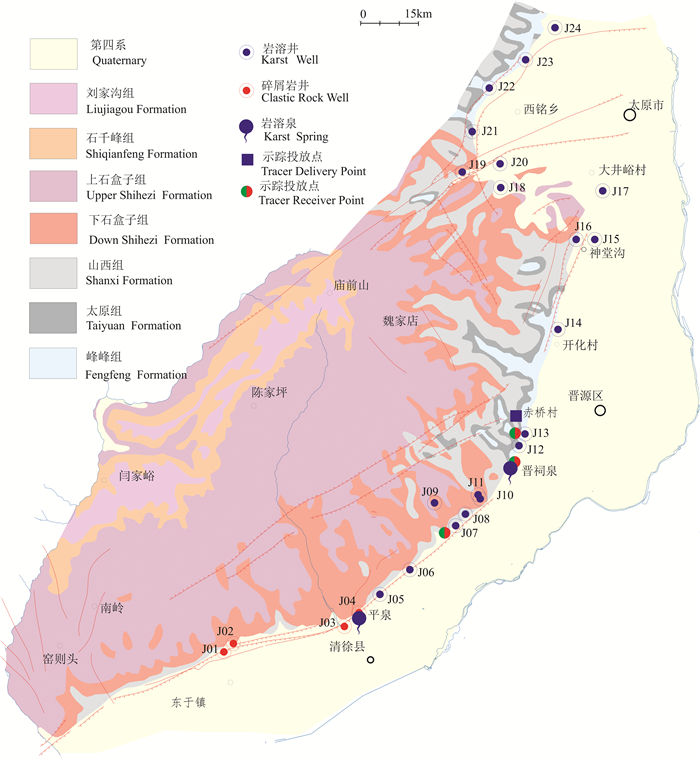
 下载:
下载:
